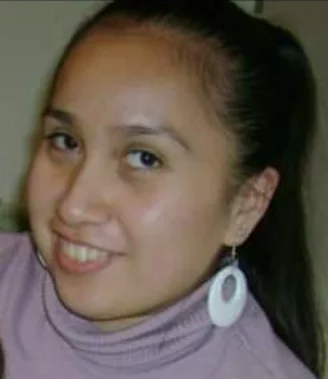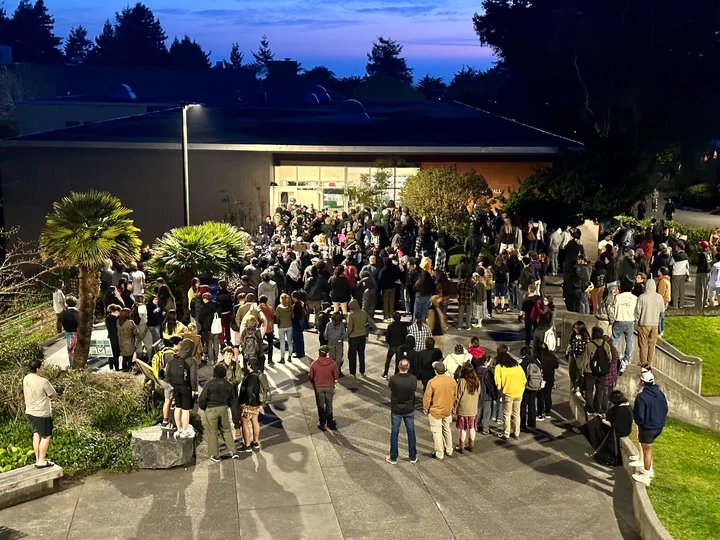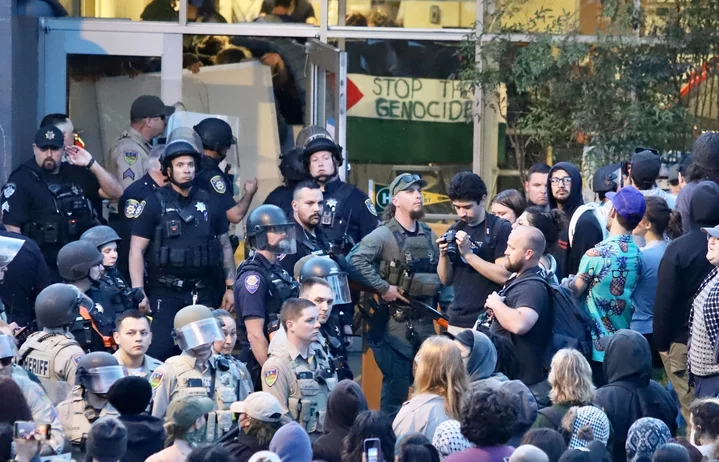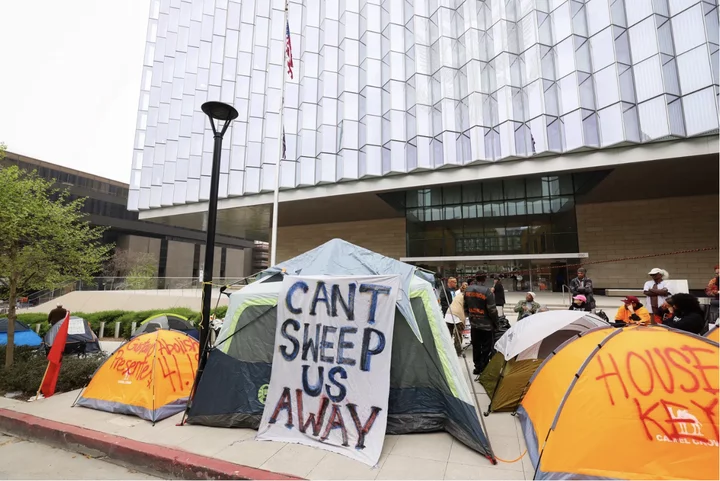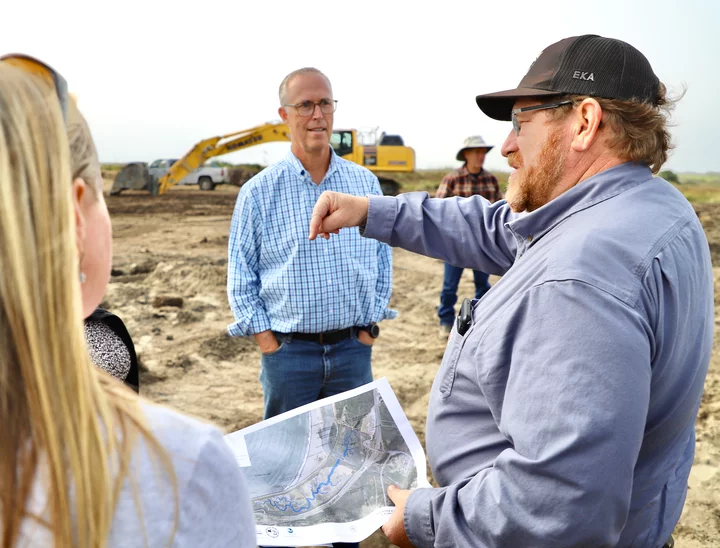Judge Rejects Changing the Name of California’s Trans Youth Ballot Measure
Carolyn Jones / Tuesday, April 23, 2024 @ 7 a.m. / Sacramento
Supporters of transgender rights gathered at the Capitol during a press conference on March 17, 2022. Photo by Miguel Gutierrez Jr., CalMatters
A group working on a fall ballot initiative that would limit the rights of transgender students lost a round in court Monday when a judge sided with the state in its description of the measure.
Sacramento County Superior Court Judge Stephen Acquisto ruled that Attorney General Rob Bonta’s title, “Restricts Rights of Transgender Youth,” is a fair description of the initiative, which would require schools to notify parents if a student identifies as transgender, ban gender-affirming care for those under 18 and place other limits on students who identify as a gender other than what they were assigned at birth.
The ruling is a setback for the group, dubbed Protect Kids California, as it tries to meet a May 28 deadline to collect 550,000 signatures to qualify for the fall ballot. The group has so far raised just over 200,000 signatures, organizers said.
Protect Kids California, led by Roseville school board member Jonathan Zachreson, put forth the initiative in November, calling it the “Protect Kids of California Act,” but a day after the group filed its paperwork with the Secretary of State, Bonta gave the initiative a new name and summary. The new name, Restricts Rights of Transgender Youth, and description made it harder to collect signatures and donations, Zachreson said, leading the group to sue for a name they said would be more reflective of the initiative’s goals.
It’s not unusual for groups to sue the state attorney general over ballot initiative language, in hopes of getting a more persuasive name or summary. Ballot language can significantly influence voters’ opinions of initiatives, according to polling by the Public Policy Institute of California, especially among voters who aren’t well informed on issues. Judges usually side with the attorney general, citing a state election code that says the court should overturn the attorney general’s ballot language “only upon clear and convincing proof that the material in question is false, misleading, or inconsistent.” As Sacramento Superior Court Judge Laurie Earl put it in 2020, “The court is not a copy editor.”
Beyond the current initiative, challenges to LGBTQ student rights have been erupting at school boards up and down California for at least a year, largely at the behest of Assemblyman Bill Essayli, a Republican from Riverside. Essayli proposed a bill in 2023 that would require schools to notify parents about students’ gender identity, and when the bill didn’t get a hearing in the Assembly education committee he took his campaign directly to school boards.
School boards in Chino, Temecula, Roseville, Rocklin and Anderson are among those that have recently passed parental notification policies, stoking the wrath of Bonta and Gov. Gavin Newsom. In September, Bonta sued Chino Valley Unified over its policy, claiming it’s discriminatory, and a judge granted a preliminary injunction in October.
Protect Kids CA originally proposed three separate initiatives addressing the rights of transgender students but last fall combined them into one. If it passes, the initiative would:
- Require students to use bathrooms that align with the gender they were assigned at birth
- Prohibit transgender girls in seventh grade or older from participating in girls sports or other girls-only activities
- Ban gender-affirming health care — including surgery or hormone treatment — for transgender students under age 18, even if parents consent or the treatment is recommended by a doctor
- Require schools to notify parents if students change their pronouns or otherwise signal they identify as a gender other than what’s on their official student records
At a hearing Friday, Zachreson’s group argued that the state’s ballot language is biased and misleading, and doesn’t accurately reflect what the initiative would do. Bonta’s summary says the initiative would require parental notification “without exception,” but Zachreson’s group argued that schools would be required under existing law to not inform parents if students would be subject to abuse or neglect at home as a result.
Attorneys also argued over the definition of “privacy.” The California Department of Education says that students have a right to privacy on issues related to their gender identity. Attorneys for Protect Kids CA argued that the policy was never approved by voters, courts or the Legislature, and in fact federal law says parents have a right to view student records.
###
The Calmatters Ideas Festival takes place June 5-6! Find out more and get your tickets at this link.
CalMatters.org is a nonprofit, nonpartisan media venture explaining California policies and politics.
BOOKED
Today: 11 felonies, 16 misdemeanors, 0 infractions
JUDGED
Humboldt County Superior Court Calendar: Today
CHP REPORTS
No current incidents
ELSEWHERE
Governor’s Office: Governor Newsom announces appointments 12.12.2025
County of Humboldt Meetings: Fish & Game Advisory Commission Agenda - Regular Meeting
Governor’s Office: TIME’s Person of the Year was Made in California
Governor’s Office: Governor Newsom visits LA recovery efforts in Altadena and the Palisades, views homes set to be completed soon
OBITUARY: Magnolia Yellowhorse White, 1987-2024
LoCO Staff / Tuesday, April 23, 2024 @ 6:56 a.m. / Obits
Magnolia Yellowhorse White was born on June 29, 1987 to Peggy Sue Gensaw and Steven Bruce Kaye. She was an enrolled member of the Yurok Tribe, but was also Karuk, Tolowa, Chetco, Navajo and Hopi.
She was born and raised in Humboldt County but spent most of her childhood traveling to see family and attending numerous cultural events. Maggie started dancing at pow wows as soon as she could walk. She danced many styles but decided to focus on being a women’s traditional dancer. She took pride in the fact that she made her own regalia.
Maggie attended numerous schools in Humboldt County and graduated from Zoe Barnum HS. In those years she participated in cheerleading, tennis, JROTC and various school clubs. More recently she had been attending classes at College of the Redwoods to further her education.
Maggie was a proud mother to four beautiful children. As a devoted mother, she raised her kids in parts of southern Oregon and northern California. Much of her adult life was spent making memories with her family and loving her kids with all of her heart.
Maggie was full of life and enjoyed many things. She liked being outdoors hiking, biking, and found comfort in going to the beach. She also enjoyed cuddling with her kids and cats to watch shows and movies, as well as listening to music. Maggie was also a very talented artist. Through her artwork, she was able to express herself. She had a great sense of humor and brought beauty and light into the world through her smile and laughter.
She spent her final days surrounded by family before passing peacefully in Santa Rosa on April 10, 2024.
She is survived by her children Aeris, Magnolia, Enoch, and Johann White. Brother Jaimoe Kibby, sisters Kristin Kaye, Jasmine Gensaw-Kaye, Camelia Cardoza, and father Bruce Kaye. She comes from a huge family and leaves behind many aunts, uncles, cousins, nieces, and nephews. She was preceded in death by her maternal and paternal grandparents and mother aawok Peggy Sue Gensaw.
She will be laid to rest in her family plot in Requa on Saturday, April 27 at 1 p.m. Friends, family, and loved ones are welcome to join and say final farewell. A celebration of life will be held at a later date this summer.
###
The obituary above was submitted on behalf of Maggie White’s loved ones. The Lost Coast Outpost runs obituaries of Humboldt County residents at no charge. See guidelines here.
(UPDATING) Major Pro-Palestine Protests at Cal Poly Humboldt Provoke Massive Police Response; Protesters Occupy Siemens Hall; Reports of Violent Force Between Activists and Law Enforcement
Hank Sims / Monday, April 22, 2024 @ 8:27 p.m. / Emergencies
UPDATE, 11:30 p.m.: And just like that, law enforcement called it a night. Just before 11 p.m., all assembled officers left the front of Siemens Hall, allowing the students out front full access.
The protesting is not done, though. A few dozen of the demonstrators have moved on to the Humboldt County Courthouse — see above — to wait in solidarity for the release of the unconfirmed number of students who were arrested earlier in the evening.
# # #

UPDATE, 10:37 p.m.: It has been quiet in the last hour. People seem to be settling in for the night.
###
UPDATE, 9:30 p.m.: Things are starting to get a little tense, as can be seen in the video above. Protesters inside the building are communicating via signs with the people outside. The police are between them.
The CHP helicopter that had been circling the scene has left, due to weather and — apparently — a close call with a drone.
###
UPDATE, 9:20 p.m.: Press release from Cal Poly Humboldt:
Several protesters are occupying Siemens Hall, an academic and administrative building on campus. Campus is closed through Wednesday, April 24 for the safety of the campus community.
The University is deeply worried about the safety of the students who remain in the building.
The University is urgently asking that the students listen to directives from the law enforcement that has responded and peacefully leave the building.
Students and others are advised to avoid the area of the building, as it is a dangerous situation.
Several protestors inside have barricaded themselves inside the building with furniture, vandalized parts of the building, and blocked entrances and elevators with tents, violating fire codes and creating extreme safety hazards for those inside.
The situation began at approximately 4:50 p.m. when University Police received reports of dozens of protesters occupying the building.
Classes in Siemens Hall were canceled, and the five courses that were in progress were evacuated. The building was shut down after protesters refused to leave voluntarily.
###
UPDATE, 9:10 p.m .: The crowd has only gotten larger after nightfall. The Outpost estimates that about 300 people are standing outside Siemens Hall.
Arcata City Councilmember Sarah Schaefer came up to the witness what was going on. “From what I can see outside, I think this is overkill,” she says of the police response.
###
UPDATE, 9 p.m.: Cal Poly Humboldt has announced that the campus will be closed until at least Wednesday. Police dispatch chatter notes that they’ll be shutting off WiFi to the building.
###
UPDATE, 8:25 p.m.: Things seem at more or less a stalemate at the moment, as night falls, per this video from the Outpost’s Andrew Goff, but a police dispatch channel notes that a CHP riot team is en route from Redding.
###
Photo: Andrew Goff.
Law enforcement officers from throughout the region have descended on Cal Poly Humboldt this evening, as pro-Palestine protesters conduct a major demonstration at the university. The protesters have occupied Siemens Hall, and are reportedly confronting police.
It is perhaps the most tense confrontation between Humboldt County law enforcement and local activists in decades. At about 7:45 p.m., one officer told dispatchers that there were about 100 protesters near the hall, with multiple fights taking place. The officer reported that other police had attempted to take students into custody, but the crowd had pulled them back.
At one point another officer called for a pepper ball launcher to be delivered.
At the same time, officers from Calfire, the California Highway Patrol and the Ferndale police could be seen speeding through Eureka toward the scene. Ambulance and fire personnel are staged away from the action at locations around the university.
Lost Coast Outpost “Scanner Traffic Indicates” correspondent “Todd,” noted at around 6:30 p.m. that a protest on the campus was getting out of hand at the same time as two major rescue operations were underway in the east part of the county. At around 7:30 p.m. — about an hour before sunset — a CHP helicopter that had been working those rescues was diverted to the incident, according to scanner traffic.
According to the @humboldtforpalestine Instagram account, which posted a statement at around 7 p.m., protesters are demanding that the university “disclose all holdings and collaborations with the zionist entity,” an academic boycott of Israeli universities, proactive pardons for the protesters and, finally, an immediate ceasefire and end to the occupation of Palestine.
The university has canceled all classes in Siemens Hall for the time being.
The Outpost’s Andrew Goff is at the scene. We will be updating this post.
Supreme Court Hears Arguments in Major Homelessness Case
Marisa Kendall / Monday, April 22, 2024 @ 2:10 p.m. / Sacramento
Tents outside the First Street U.S. Courthouse in Los Angeles, where homeless advocates and supporters rallied as the U.S. Supreme Court in Washington D.C. heard oral arguments in the Grants Pass case on April 22, 2024. Photo by Ted Soqui for CalMatters
In a case that could drastically alter how cities in California and beyond deal with homeless encampments, U.S. Supreme Court justices today weighed whether to allow broader punishment for people camping in public spaces.
“Laws like ours, they really do serve an essential purpose,” said Theane Evangelis, arguing on behalf of the city of Grants Pass, Oregon, which banned encampments. “They protect the health and safety of everyone. It is not safe to live in encampments. It’s unsanitary, we see what’s happening. And there are the harms of the encampments on those in them and outside.”
If the justices side with Grants Pass, they could roll back limits that for years have curtailed cities’ ability to clear encampments and punish campers. Two prior Ninth Circuit appellate rulings determined that penalizing an unhoused person for camping in public, if they have nowhere else to sleep, violates the Constitution’s 8th Amendment ban on cruel and unusual punishment.
The Supreme Court’s opinion is expected in late June. However the justices come down, it will affect cities throughout the country. But nowhere will it be felt as acutely as in California, where nearly half of the country’s entire unsheltered homeless population lives.
What’s at stake in the Grants Pass case?
The case, Johnson vs. Grants Pass, stems from a 2018 lawsuit challenging ordinances that ban camping even when there are no beds available in a homeless shelter. Because humans need to sleep somewhere, homeless residents of Grants Pass sued, claiming the ordinance criminalizes them for being homeless and violates the 8th Amendment.
“The ordinances by design make it physically impossible for homeless people to live in Grants Pass without facing endless fines and jail time,” said attorney Kelsi Brown Corkran, who argued on behalf of the homeless respondents today.
The lower courts sided with the homeless residents. Now, Grants Pass is asking the Supreme Court to overturn that ruling.
More than three dozen elected officials and organizations — including California Gov. Gavin Newsom — filed briefs weighing in on the case. Cities, law enforcement agencies and Newsom say the prior rulings tie their hands as they try to manage dangerous and unsanitary encampments. Several cities, including San Francisco, Sacramento, Chico and San Rafael, have been hit with court orders stopping or delaying them from clearing encampments.
But advocates for the civil rights of unhoused people worry if the former rulings are overturned, cities will be able to arrest people just for being homeless.
What did the justices say?
At times, the Supreme Court seemed divided along ideological lines, with the liberal justices appearing more sympathetic to the homeless residents’ arguments than their conservative counterparts. The Supreme Court has a 6-3 conservative majority.
Justices Sonia Sotomayor and Elena Kagan, both appointees of former President Barack Obama, grilled the Grants Pass attorney over her claim that the city’s ordinance does not make it a crime to be homeless.
“Where do we put them if every city, every village, every town lacks compassion and passes a law identical to this?” Sotomayor asked. “Where are they supposed to sleep? Are they supposed to kill themselves not sleeping?”
But even Justice Brett Kavanaugh, an appointee of former President Donald Trump, poked holes in the Grants Pass argument that the city’s camping ban helps get people off the street and into shelter.
“How does it help if there are not enough beds for the number of homeless people in the jurisdiction?” he asked the Grants Pass lawyer.
“This is a difficult policy question,” Evangelis answered, adding that the ordinance encourages people to accept shelter beds when they open up.
After multiple citations under the Grants Pass ordinance, a homeless resident could go to jail. What then? Kavanaugh asked. “You end up in jail for 30 days, and then you get out, I mean, you’re not going to be any better off than you were before in finding a bed,” he said.
Evangelis insisted an arrest often is what pushes people to finally accept help, whether it’s treatment or other services.
The justices homed in on a key question of the case: Because Grants Pass prohibits camping throughout the entire city, does the ordinance criminalize the status of being homeless? Or does the ordinance criminalize the behavior of camping in public?
That’s important because, decades earlier, the Supreme Court found a person cannot be punished for their status, but only for their actions — someone cannot be arrested for being addicted to drugs, for example, but they can be arrested for using drugs.
In addressing the status-versus-action question, the justices ventured down some philosophical rabbit holes. The conservative justices scrutinized the rationale used in the prior rulings.
“Is being a bank robber a status?” Chief Justice John Roberts Jr., an appointee of former President George Bush, asked. And: If someone is hungry and needs food to survive, can they be punished for breaking into a store?
 A woman listens to audio from the U.S. Supreme Court oral arguments in a lawsuit against the Oregon city of Grants Pass, in Los Angeles on April 22, 2024. Photo by Ted Soqui for CalMatters
A woman listens to audio from the U.S. Supreme Court oral arguments in a lawsuit against the Oregon city of Grants Pass, in Los Angeles on April 22, 2024. Photo by Ted Soqui for CalMattersIf someone has no access to a bathroom, can they be punished for urinating or defecating in the street? Justice Amy Coney Barrett, a Trump appointee, asked. Where do we draw the line? She wanted to know.
Supporters of the homeless plaintiffs in Grants Pass say this isn’t a liberal-versus-conservative issue.
“We can’t predict what the court is going to do, but every single time the court has heard this question, they’ve agreed that punishing people for sleeping outside when they have nowhere else to go is cruel and unusual,” Jesse Rabinowitz, communications director for the National Homelessness Law Center, said during a media call that included a lawyer representing the homeless respondents. “So we remain hopeful that the Supreme Court will do the right thing and agree with all the lower courts’ decisions and affirm that everybody, regardless of housing status, is protected by the constitution.”
Lawyers for Grants Pass did not respond to emails seeking comment.
People rally at the courthouse
As the justices considered the case today, hundreds of people rallied in front of the Supreme Court in Washington D.C. to speak out against criminalizing homelessness. People also gathered in Los Angeles and San Francisco.
Ann Olivia, CEO of the National Alliance to End Homelessness, attended the D.C. rally and said it was heartening to see so many people supporting the rights of unhoused people.
But, she said, “whatever happens in this case isn’t going to create more affordable housing and services for people.”
###
CalMatters.org is a nonprofit, nonpartisan media venture explaining California policies and politics.
Rep. Huffman’s Office Announces $6 Million in Inflation Reduction Act Funds to Help Restore Elk River
LoCO Staff / Monday, April 22, 2024 @ 2:09 p.m. / D.C.
Rep. Jared Huffman tours the City of Eureka’s new wetlands near the mouth of the Elk River in 2022. File photo: Andrew Goff.
###
Press release from the Office of Rep. Jared Huffman:
Today, U.S. Representative Jared Huffman (CA-02) shared the news that the Elk River Estuary has been selected by the National Oceanic and Atmospheric Administration (NOAA) to receive $6 million in federal funding for a large-scale habitat restoration project. This funding was made possible through the Inflation Reduction Act and Bipartisan Infrastructure Law, which Rep. Huffman helped pass.
“Our coasts are getting battered by climate change – and that has serious consequences for ecosystems, wildlife, and the communities that rely on healthy coastal habitats,” said Rep. Huffman. “This forward-looking project on the Elk River will upgrade vital infrastructure to increase resilience to sea level rise and protect habitat for the region’s iconic salmon. Projects like this are exactly what I had in mind while shaping Democrats’ historic legislation to invest in America and our future; and I’m glad I could help bring this funding home.”
“We’re deeply grateful to NOAA’s Coastal Zone Management program for their generous support, particularly as state funding diminishes. This award marks a pivotal moment in our mission to protect and recover wild fish and their habitats,” said Darren Mierau, North Coast Regional Director, CalTrout. “This award will allow us to transition from our engineering design phase with funding from the State Coastal Conservancy to implementing crucial coastal resilience projects on the Elk River. Through infrastructure upgrades, we will protect agricultural lands, restore vital habitats for native salmon, and enhance resilience against sea-level rise along Humboldt Bay’s shoreline. Together, we’re building a future where rivers thrive, and coastal communities prosper.”
The Elk River Estuary Restoration Project is the initial implementation step of a decades-long, community-based program to resolve legacy sediment and water quality impairment issues from excessive timber harvest, while also providing regional resilience to sea level rise and large episodic storm events. The project is intended to improve hydrologic and sediment processes, water quality conditions, and aquatic and riparian habitat functions in Elk River, ultimately reducing nuisance flooding in rural residential properties and agricultural land in this economically disadvantaged community.
This project is a part of a nationwide $123 million tranche of funding across state and territorial coastal management programs and national estuarine research reserves.
“These transformational projects will not only bolster community resilience, but also ensure that innovations are fairly and broadly accessible,” said Jainey K. Bavishi, assistant secretary of commerce for oceans and atmosphere and deputy NOAA administrator. “This significant increase in resources from NOAA will be essential in helping to build local infrastructure that is climate resilient, while providing essential benefits to businesses.”
These investments will complement and leverage other opportunities for habitat conservation and restoration, including funding through NOAA’s Community-based Restoration Program and the National Oceans and Coastal Security Fund. The restoration and conservation of ecologically significant ecosystems, such as wetlands, corals and natural shoreline, will help reduce the impacts of coastal hazards — including flooding and climate change — to property and infrastructure, and at the same time provide economic benefits to coastal communities.
Visit NOAA’s Bipartisan Infrastructure Law and Inflation Reduction Act websites to learn about current and future funding opportunities.
Missing Person’s Car Found in SoHum May Have Been Swept Downstream by Winter Storms; Search Continues
LoCO Staff / Monday, April 22, 2024 @ 10:10 a.m. / Crime
Press release from the Humboldt County Sheriff’s Office:
On 4/12/2024, at about 4:00 p.m., Humboldt County Sheriff’s deputies were dispatched to the report of missing person in the Southern Humboldt County area. The missing person was identified as 65-year-old Terry McInnes of Piercy. It was learned that McInnes was last seen by friends and neighbors on or around March 24th, 2024. The reporting party was concerned based on the lack of contact with McInnes due to it being out of character. As McInnes is a resident of Mendocino County, a missing person report was taken and the information was forwarded to the Mendocino County Sheriff’s Office.
On 04/17/2024, at about 8:00 a.m., the Humboldt County Sheriff’s Office was contacted and informed that McInnes’ vehicle had been located unoccupied in the East Branch of the South Fork of the Eel River just north of the Humboldt/Mendocino county line. Humboldt County Sheriff’s Deputies responded to the area and conducted a search, with assistance from a California Highway Patrol helicopter, in an effort to locate McInnes. This search continued the following day with deputies being assisted by members of the Southern Humboldt Technical Rescue team. Preliminary information suggests that McInnes may have attempted to ford a section of private roadway that crosses the river in that area during periods of significantly increased water flow at the end of March, resulting in the vehicle being swept downstream. The Humboldt County Sheriff’s Office has been working with the Mendocino County Sheriff’s Office and is continuing to conduct search efforts in the area.
Anyone with information about this case is encouraged to call the Mendocino County Sheriff’s Office at (707) 463-4411 (M.C.S.O. Case # 2024-7377), the Humboldt County Sheriff’s Office at (707) 445-7251 or the Sheriff’s Office Crime Tip line at (707) 268-2539.
Students’ Environmental Ideas Shine in CalMatters’ 2024 Earth Day Contest
Sonya Quick / Monday, April 22, 2024 @ 7:49 a.m. / Sacramento
Wildflowers in bloom during a superbloom in Carrizo Plain National Monument in Santa Margarita on April 25, 2023. Photo by Julie A Hotz for CalMatters.
The winners of CalMatters’ second annual Earth Day op-ed contest are in, spotlighting the ways in which climate solutions play an important role in this year’s election.
More than 70 high school students across California entered this year’s contest, calling on candidates seeking office to back a variety of policies. Entries were rich in research, tracking oil industry contributions, evaluating carbon trading prices and forest restoration, proposing binational projects and more. Some entries called for boosting and tidying public transit systems to appeal to more Californians.
“There is constant talk of climate solutions in California, but rarely do we hear from the folks that will be most affected by today’s decisions – good or bad,” says California Voices editor Yousef Baig. “This contest is a chance to give them a platform and recognize gifted young writers across our state.”
The first place winner earned $500 with another $500 for their school’s journalism program. Second and third place finishers earned $300. All students with leading entries were able to participate in direct coaching sessions with Baig.Some teachers used the contest as a classroom activity.
“We saw young people engaging in journalism for their first time and pitching solutions to publications,” says Youth Journalism Initiative manager Michael Lozano. “It’s fulfilling to be a conduit for the next generation, to remind them that their unique experiences and perspectives matter.”
Let’s take a look at this year’s winners:
First Place, Emma Kavcioglu
Kavcioglu is a junior at Granada Hills Charter High School, and she serves as the opinion editor for her school newspaper, the Plaid Press.
What inspired your writing?
I decided to enter the contest after my journalism teacher told me about the contest and recommended that I enter. I work as the opinion editor on my school paper, so I was really excited to get to work on my Op-Ed for the CalMatters competition. My family and I were personally relocated due to a gas leak when I was 8 years old, and the feelings and memories of that experience became the inspiration for the piece.
What is it like being a finalist?
I felt honored to be considered as a finalist in the contest. Getting such a high level of commendation from CalMatters really stands as evidence of how much I have grown and learned in my high school journalism endeavors. I felt very proud to be recognized for my writing, and working with the CalMatters Team throughout the editing process has given me a valuable new perspective on how major publications function, setting me up for success in the workplace.
Second Place, Sophia Bella
California has to rid itself of a ‘no’ mentality to change its relationship with cars
Sophia Bella is a junior at Burlingame High School and managing editor of The Burlingame B.
What inspired your writing?
Every day on my way to school, I pass the steel poles of our local Caltrain electrification project, which was scheduled to be operational by 2022. Now, two years past its deadline, the project is still incomplete. In my high school newsroom, the “train story idea” has turned into a running joke, as it has been repeatedly pitched over the past three years without any local signs of progress. For decades, officials have promised transformative infrastructure projects that repeatedly fail or are delayed in execution. Frustrated with this pattern, I viewed this contest as a perfect opportunity to merge my passions for journalism and environmentalism, and to discuss this pervasive issue on a larger platform.
What is it like being a finalist?
I think it shows that writing about issues you care about can go a long way, and participating in advocacy for change is accessible to everyone.
Third Place, Reid Heavner
Reid Heavner is a freshman in Santa Rosa and staff writer for his high school newspaper.
What inspired your writing?
Originally, I entered the contest because of my school’s journalism program. I would never have known that I could even enter without my school’s program. As I worked on my submission, it started to become more than just the assignment that it started out as. There was definitely a moment where I looked at what I had just written and realized that it was actually pretty decent. I never thought that it would get selected, but I was proud of what I had written. At that point, it was sort of a fun thing, where I was just interested to see where it would go and how it would turn out. I was inspired in large part by my mother. She works as a policy writer at the Frontier Group, in which she confronts similar issues to those discussed in our articles. She helped me to pick my topic and worked with me to revise what I had written. My article definitely wouldn’t’ve turned out as well as it did without her.
What is it like being a finalist?
Being a finalist was an amazing surprise for me. I remember seeing the email telling me that my article had been selected and being in disbelief for a moment. It was an especially amazing moment because I was at a journalism convention when I found out. That weekend was already an exposure to big-time journalism outside of just my school, and hearing that I would be published in CalMatters added a level of validation to that where I felt part of the journalism community.
Honorable Mentions
Other honorable student work is rounded up in a central commentary piece.
California youth spotlight election-year priorities on climate
###
CalMatters.org is a nonprofit, nonpartisan media venture explaining California policies and politics.


